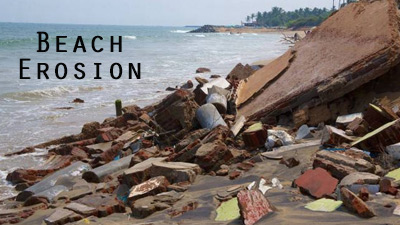Disappearing Beaches
- POSTED ON: 15 Dec, 2017
- TOTAL VIEWS: 942 Views
- POSTED BY: Ramnath K. Chandrasekhar
- ARTICLE POINTS: 100 Points

Beaches and coasts are amazing wonders of nature. India’s coastline stretches for around 7,500 kilometres. Quite apart from the beautiful beaches, they also support an incredible diversity of wildlife like flamingos, shore birds, Olive Ridley turtles and red crabs.
India’s beaches are visited by millions of people every year too. But have we thought how our beaches are formed? They are formed because of the rivers. That’s why majority of our coastline have sandy beaches.
The rivers draining into the sea transport the large amount of sand that is gradually accumulated along their course. The sea currents moving from south to north direction in the Bay of Bengal and the vice versa in the Arabian Sea deposits the ‘flowing’ sand along the coast.
The sea waves act as the engines of sand transportation. They drive the movement of sand to form beaches. The amount of sand and sediments deposited in our beaches is a whooping 1.2 billion tonnes every year! Isn’t this an amazing natural phenomenon?
These beaches act as a defence mechanism for coastal villages from large waves and natural calamities. But they are destroyed permanently every year at an alarming rate because of construction activities right on the beach.
The classic example for this is the Puducherry harbour. After it was built in the mid 1980s, the authorities realised that the harbour was too shallow for the ships to enter. So they abandoned it. Only smaller fishing boats use it today.
But just the two ‘breakwaters’ that were built to form the harbour were enough to spark beach erosion. These breakwaters are long strips of construction with boulders. They jut out into the sea for many meters. One of the reasons these are built is to reduce the wave action so that the ships are anchored safely. The unintended consequence of constructions like these is erosion of beaches.
Because the sea currents move from south to north in the Bay of Bengal during the major part of a year, the incoming sand from the rivers is accumulated on the southern side of the breakwater while the northern part of gets eroded, in a matter of months.
This is the reason for erosion of the pristine beaches in Puducherry. With the protective barrier of beaches vanishing, the sea has engulfed fishing settlements, putting livelihoods at stake.
Even the temporary solution of depositing rocks along the beaches seals the opportunity for beach formation. This method not only destroys the hills and forests but also adds to further beach erosion.
It is extremely important that every one of us must know about such natural phenomenon that occurs in nature.
As much as 40% of India’s coastline is eroding at an alarming level, not only in Tamil Nadu and Puducherry, but also in many other beaches. It is time we look at sustainable methods of construction and scientifically proven beach restoration methods so that we do not lose our beaches forever.